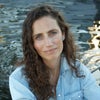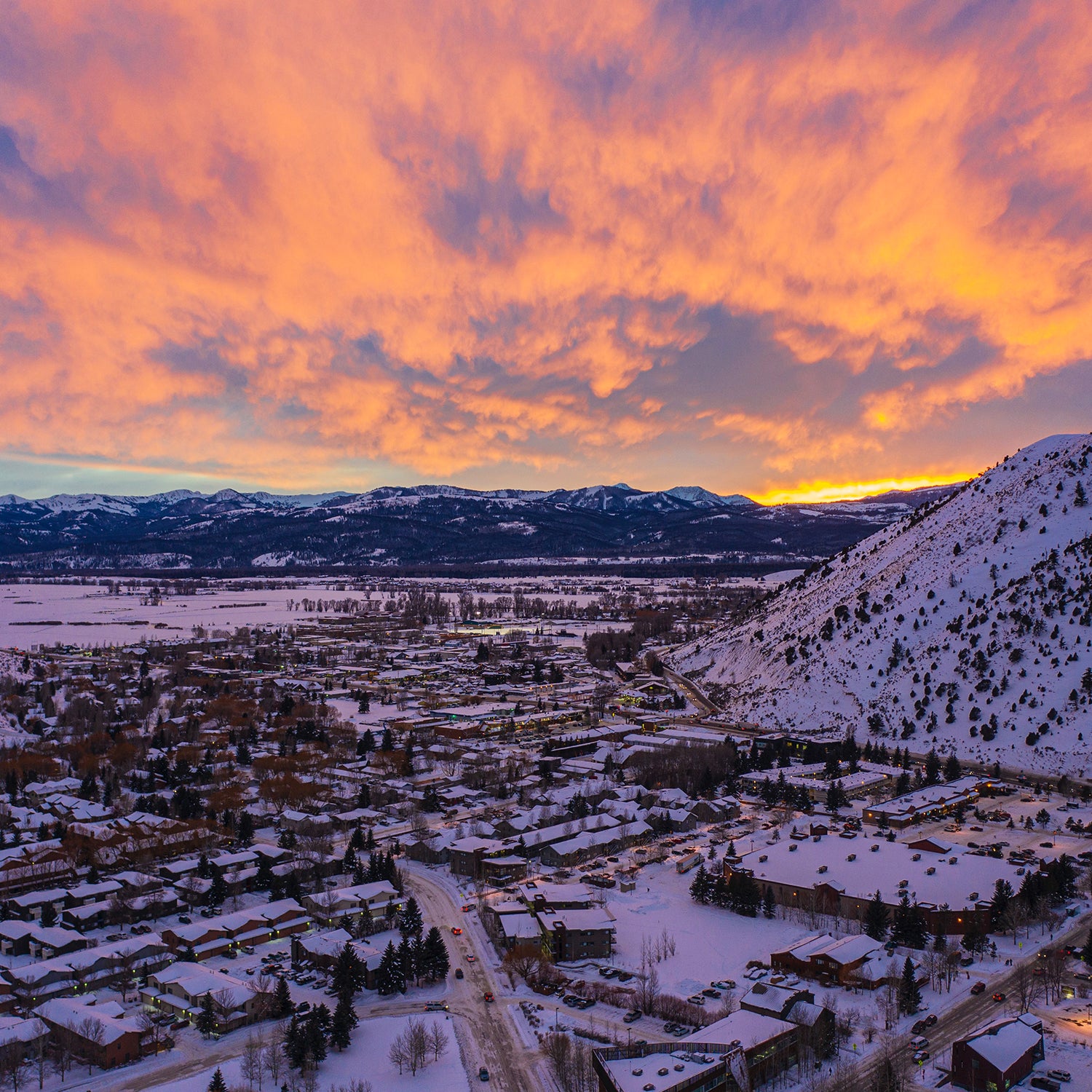Head in any direction from the picturesque square at the center of Jackson Hole, Wyoming, and you’ll soon be on public land, among the spiny peaks of the Tetons or meadows full of elk. Along the way, you will inevitably roll past sprawling ranches and huge houses that dot the landscape. Unless you’re paying close attention, you may miss the trailers tucked into the hollows.
A new book by Yale sociologist Justin Farrell, Billionaire Wilderness, posits that Teton County has become an extreme example of a widespread dynamic in the West, where land protections limit development and drive up prices. Concurrently, the local economy tends to rely on tourism and recreation—industries that require both low-wage jobs and incoming wealth. “This is the richest area in the U.S., but it’s also the most unequal,” Farrell writes.
Teton County is home to two of the country’s most popular national parks, Yellowstone and Grand Teton, plus three ski areas—and 97 percent of it is public land. That means that while casual tourists will mostly notice the wide ranges of open space, private landowners and businesses must squeeze into the tiny parcels that are available to develop. Lots of people who commute to the area for work can’t afford to live there: in 2018, the average price for a single-family home in Jackson, the county’s main town, was $2.65 million.
Billionaire Wilderness frames Jackson as a microcosm of wealth disparity and inequality driven by peoples’ desire to be near wilderness, regardless of their income, a place where the reality of finite available land bumps up against outdated myths about the ever expanding American West. At the center of the breakdown between truth and romanticism are difficult questions about how we manage American wilderness. Who is it for? Who decides where it should be preserved? Is open space more important than affordability and access?
Farrell brings a good mixture of information and perspectives to his research. He was raised in Wyoming and grew up watching his mother clean huge houses but was rocketed into a different socioeconomic sphere through his Ivy League sociology job. As he examines Teton County’s inequality through lengthy interviews and data analysis, he wonders why an area with such a mind-boggling amount of wealth ignores things like social services and affordable housing. He concludes that it’s a combination of tax policy, misguided philanthropy, and that tricky, mythological fascination with the rural West, which can be conveniently tailored to suit selfish needs.
Through Farrell’s analysis, readers of Billionaire Wilderness learn that Teton County has the highest per capita income in the country: $194,485. That’s more than 30 percent higher than Manhattan’s rate, $148,002. But because eight out of ten dollars come from investment income instead of wages, the top 1 percent of the county makes an average of $28.2 million annually (mostly from investments), while the average worker makes $41,052 a year. The people who serve at restaurants and clean houses to support tourism in the area—jobs necessary to keep the local economy running—often don’t earn enough to live in town. Instead, Farrell finds, they drive over sketchy mountain passes from Idaho or sleep in shifts in trailers to get by.
While many people want to live in the area because it’s beautiful and offers great outdoor access, Farrell finds that part of the draw for the wealthy is less prosaic: lenient taxes. Wyoming is number one on Bloomberg Wealth Management’s ranking of America’s most wealth-friendly states, thanks to its lack of income tax and minimal property taxes. A household making $10 million could save $700,000 in taxes by switching its legal residency from, say, Connecticut, which exacerbates local inequality even more. “Lawyers and doctors are middle class in Jackson,” one disgruntled local tells Farrell. “Even they can’t make it work.”
With so much money in such a small place, it seems like an equitable county should be possible. Can’t such extreme wealth solve the problems it creates, simply by redirecting resources? Indeed, Farrell discovers that Teton County is one of the most philanthropic places in the nation. Community events like Old Bill’s Fun Run for Charities have raised more than $14 million in a single morning for groups such as the Art Association of Jackson Hole or the Rocky Mountain Elk Foundation. But donors contribute most to organizations aligned with their moral and philosophical views—usually revolving around conservation and art—not the groups that address Teton County’s direst needs. Philanthropy is frequently used as a tax break, a way to get in with the right crowd, or a way for guilty business titans to feel better about themselves.
“You see a lot of charity but very little justice,” a nonprofit worker, Margarita Dixon, tells Farrell in the book.
That is a particular dilemma in Wyoming, where minimal taxes mean the state has extremely limited public funds. Private donations bankroll a lot of services in the county, such as housing assistance or mental-health counseling (“buzzkill issues,” as Farrell puts it). Still, most ultrawealthy donors prefer giving to charities they can relate to.
Further complicating matters is the area’s long history of rich people helicoptering in—sometimes literally—and cordoning off land against local wishes. Most famously, in 1927, John D. Rockefeller Jr. bought 114,170 acres of land north of Jackson Hole with the intent to conserve it for public good. That land became part of Grand Teton National Park in 1950. The purchase is now lauded and deemed full of foresight, but it was locally unpopular when it happened. No one liked the idea of a wealthy Easterner coming in and dominating the valley.
These days unfathomably affluent landowners continue to have outsize influence in the area by buying up huge swaths of land. But the idea of conservation through private ownership is fraught: not everyone will pull a Rockefeller and eventually make their land public. Jackson’s elite frequently buy land through the Jackson Hole Land Trust, which puts a conservation easement on their purchases. The easement gives the land trust power to limit development on the property but offsets the new owner’s property taxes as an incentive. Farrell illustrates the trend with maps of the valley in 1980 and then 2018, and in the latter, the area is a patchwork of easements. On one hand, that’s good, because it preserves wild spaces; on the other hand, no one except the private landowner is able to go there, and the scarcity of developable land drives prices even higher into the stratosphere.
Farrell did more than 200 interviews and got to know his subjects at both ends of the socioeconomic spectrum. Rich property owners around Jackson, he found, generally idealize the wild, believing that nature is pure and that preserving it is good; some even believed their conservation efforts would absolve them of whatever less pure activities they’d undertaken on their road to such extreme wealth. “The ultra-wealthy use nature to try to resolve key predicaments in their lives,” he notes. He found that while they felt somewhat guilty about their immense local power, they thought they were doing good by preserving land and providing jobs. They tended either to be unaware of, or to gloss over, the fact that many workers in the area can barely scrape by.
Jackson’s elite also tended not to have a clear read on class dynamics: they frequently confused paid workers for friends or bragged about drinking beer with the lifties and contractors. Their lack of awareness also manifested in a detached understanding of rural work. To the rich, poverty in the West was often idealized as a romanticized part of rural culture or an enviable manifestation of ruggedness compared to poverty in the urban spaces where they’d tended to make their money. But in Farrell’s interviews, Teton County’s workers were hyperaware of who paid them and how tenuous those relationships were.
Farrell clearly outlines the roots of the problems: policy, western mythologies, tax breaks, and selfishness. As a reader, I wanted more analysis of what could bring both economic justice and land protections to areas like Teton County. Billionaire Wilderness ponders what makes a good community in the 21st century; Farrell mentions trust and empathy, government incentives for smart growth and community development, and local policies designed to do less harm to low-income residents. But he doesn’t squarely answer the question. Perhaps with so many conflicting interests, there is simply no clear answer.
Americans have gone west to escape the ills of society while bringing the ills of society with them, pretty much since Manifest Destiny; one regional myth was that, once here, everyone would have the chance to experience something wild. In reality, of course, settlement always brought land-access issues, prompted human displacement, and fueled socioeconomic disparity. That remains true now, as Billionaire Wilderness makes evident through its examination of one of the most beloved playgrounds of this part of the nation. After outlining the conflicting interests between conservation and growth, affordable housing and preservation, Farrell concludes that we can’t have it all. This has always been a region that was developed according to the interests of the ultrarich, and it’s becoming more apparent who really gets to live out a western fantasy.


